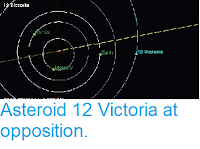Asteroid 7 Iris will reach opposition (the point at which it is
directly opposite the Sun when observed from the Earth) at 2.24 pm GMT
on Friday 5 April 2019, when it will also be at the closest point on
its orbit to the Earth, 1.83 AU (i.e. 1.83 times as far from the
Earth as the Sun, or about 273 764 000 km), and be completely
illuminated by the Sun. While it is not obvious to
the naked eye observer, asteroids have phases just like those of the
Moon; being further from the Sun than the Earth, 7 Iris is 'full'
when
directly opposite the Sun. As 7 Iris is only about 240 km in
diameter, it will not be visible to the naked eye, but with a maximum
Apparent Magnitude (luminosity) of 9.4 at opposition, it should be
visible in the Constellation of Corvus to viewers equipped with a good pair
of binoculars or small telescope.
The orbit of 7 Iris. Wikipedia.
7 Iris was discovered on 13 August 1873 by English Astronomer John Russel Hind, then at George Bishop's Observatory in London. It was the seventh asteroid discovered.
7 Iris
has an 1346 day orbital period and an eccentric orbit
tilted at an angle of 5.52° to the plane of the Solar System, which
takes it from 1.83 AU from the Sun (i.e. 183% of the the average
distance at
which the Earth orbits the Sun) to 2.94 AU from the Sun (i.e. 294% of
the
average distance at which the Earth orbits the Sun). As an asteroid that
never comes within 1.666 AU of the Sun and has an average orbital
distance less than 3.2 AU from the Sun, 7 Iris is classed as a
Main Belt Asteroid.
See also...
Follow Sciency Thoughts on Facebook.







